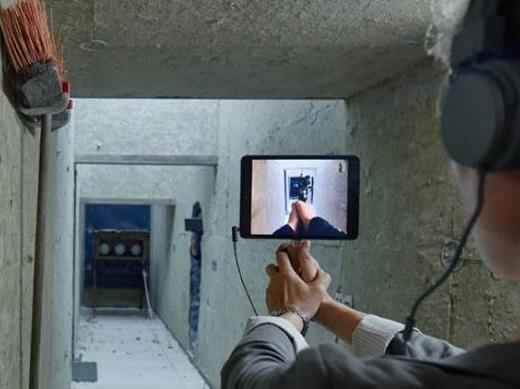To truly understand another point of view, the cliché urges us to walk in someone else’s shoes. Situation Rooms places us into the footwear of 10 very different characters, each with their own perspectives on the global arms trade.
Entering the ABC studios we are briefed on how to participate in this piece. The studio has an enclosed set constructed in the centre of the space, a small labyrinth of various rooms. Each participant in the group of 20 navigates their way through the space individually by following prompts on their iPad, and listening on provided headphones. There are 20 stories being told, of which each participant will experience 10 in a session. Using the device of episodes on the iPad, each person enters a different door into the set as they are instructed, and then follows the screen to match the movements and actions of each character in turn. Documented points of view include those of a child soldier, a war photographer, a human rights lawyer, a drone pilot, a cafeteria manager in an arms factory, a surgeon for Doctors without Borders, a computer hacker and a peace activist.
The function of following the prompts on the screen is engaging, with the sensation of trying to compose a text message while walking. Close attention is needed to follow the progress of each character, as it is difficult to reorientate when the wrong door is taken or wrong direction chosen, but clear arrows are overlaid to keep you moving quickly when the pace is quicker. The constructed set has limited physical detail, but details in the stories are depicted as overlaid video moments. In any case, the time and opportunity for independent exploration is limited, due to the need to stay in step with the action.
An interesting feature is the way that other participants are portrayed on the screen as paths intersect, the character they currently inhabit filmed on the display with their name and description hovering in front of them. At times the characters interact, and one follows instructions to remove the coat of another who is instructed to let their coat be removed, or shake hands together, for example. This type of interaction is oddly removed, with neither able to make full eye contact or to speak, ears covered by headphones. Each person is ensconced within their own narrative and each step is prescribed with accuracy to avoid collisions and to enable each documentary to play out. Logistically, wearing comfortable clothes would be recommended, as there are prompts to assume seated, crouching or lying positions, and if you require glasses for reading, these would be useful for the various instructions and subtitles that accompany the image displays.
While the technical side of this immersive piece is fascinating, the sensation of inhabiting someone else’s life is stronger with some characters than with others. This would differ from person to person, the text playing differently for each participant’s own life experiences, but I found the two most integrating parts to be the simple tale of the child soldier and the strangely familiar humdrum routine of the life of a weapons factory engineer. These two portrayals involve daily life situations and less video imagery and voiceover narrative than some other roles, but the variety of methods of presentation are good at emphasising the differences between the different lives. The mode of presentation is soothing, and makes some quite shocking pieces of information easier to absorb in some ways, only to be wondered at on later reflection. The references to major life decisions that never need to be made in Perth (for example, whether to stand and fight or to seek education and refuge in Europe in hopes of surviving to be part of the rebuilding), the realisation of the dollar-value of a life on any given day, the sedate and suburban cares of the drone pilot doing his 9-5 job – these are casually dropped into the monologue as you literally stroll along, with no chance for digestion. Which is the point – these are the small points of someone else’s life, the parts that get taken for granted.
Using the idea of the Theatre of War, the effect of weapons on the world is explored through the lives of disparate individuals. No morals are preached, no lessons learned, we simply see snippets of how it is and then are left to draw our own conclusions.
Bringing a unique production to the Perth Festival, Rimini Protokoll’s Situation Rooms is unlikely to be everybody’s cup of tea but definitely provides plenty of food for thought.
Rating: 4 stars out of 5Situation Rooms
By Helgard Haug, Stefan Kaegi and Daniel Wetzel
Presented by Rimini Protokoll
ABC Studios, East Perth
www.perthfestival.com.au
Perth International Arts Festival
8-23 February





